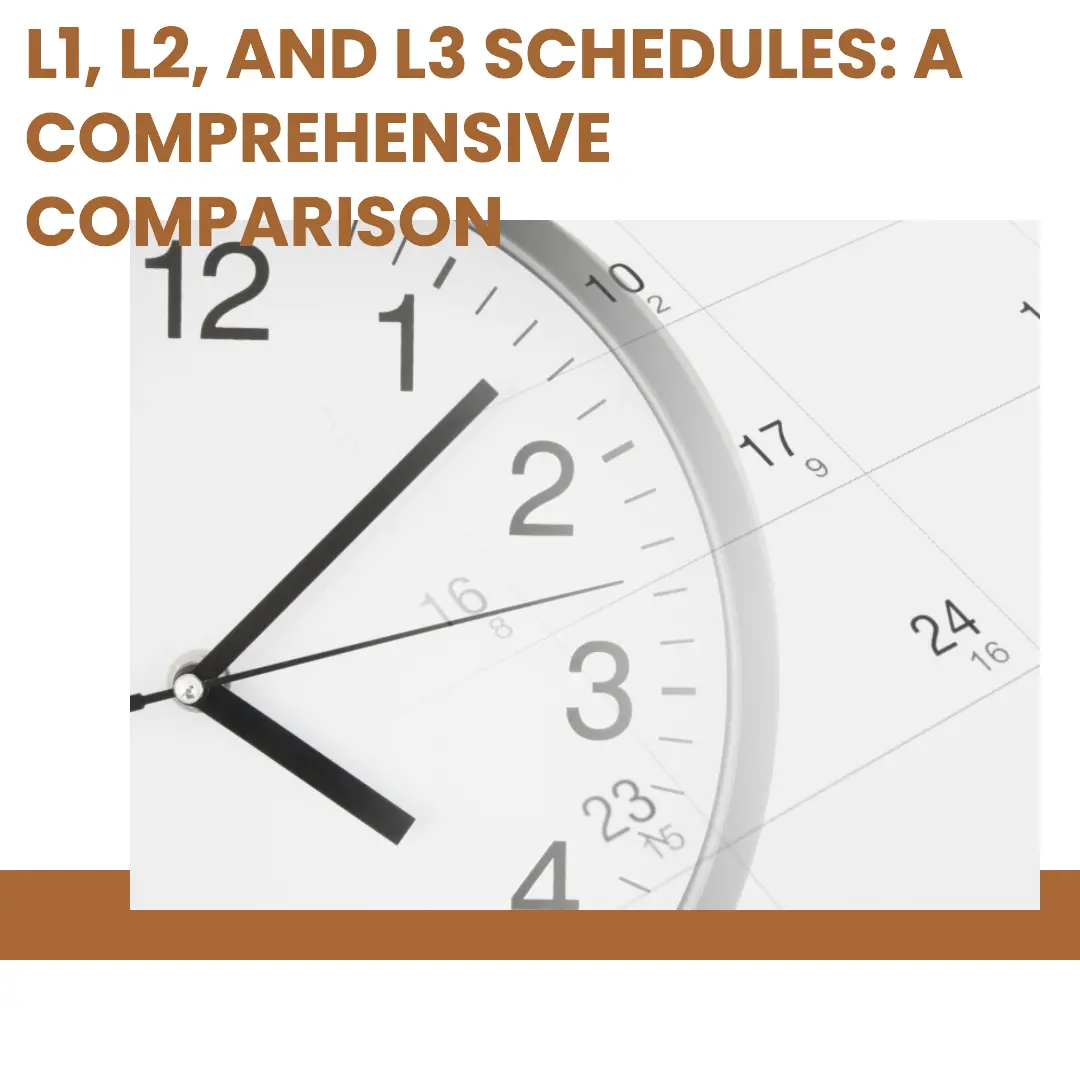I. Introduction
Hello, fellow project management enthusiasts! If you’re reading this, it’s likely that you’re already well aware of the importance of proper scheduling in the world of project management. A well-crafted schedule not only helps keep your team organized, but it also acts as a roadmap for the successful completion of your project. Today, we’re going to dive into the world of L1, L2, and L3 schedules, and explore how they can help you optimize your project management efforts.
Selecting the right level of schedule detail for a given project is critical, as it directly impacts your team’s ability to effectively plan, execute, and monitor the project. Too little detail, and you risk losing sight of important tasks; too much, and you may overwhelm your team with information. That’s where L1, L2, and L3 schedules come into play. These three levels of scheduling cater to different project requirements and offer unique benefits depending on your project’s complexity and needs.
In this blog post, we’ll provide a comprehensive comparison of L1, L2, and L3 schedules, so you can better understand their differences and applications. By the end of this post, you’ll be equipped with the knowledge to choose the right level of scheduling for your project and ensure its smooth and successful execution.
Stay tuned, as we’re about to embark on an exciting journey into the world of project scheduling!
II. L1 Schedules
A. Definition and purpose
Let’s kick off our exploration with L1 schedules, the most high-level and simplified form of project scheduling. Also known as “milestone” or “summary” schedules, L1 schedules provide an overview of your project’s major phases, key milestones, and important deadlines. The primary purpose of L1 schedules is to give stakeholders, such as clients or top management, a clear snapshot of your project’s overall progress and timeframes without delving into the nitty-gritty details.
B. Key features
L1 schedules are characterized by their simplicity and ease of understanding. They usually consist of a small number of activities or milestones, each representing a significant phase or deliverable in the project. At this level, you won’t find detailed information about individual tasks, resources, or dependencies. Instead, L1 schedules focus on the “big picture” and the high-level goals that need to be achieved.
C. When to use an L1 schedule
L1 schedules are particularly useful for:
- Communicating project status to external stakeholders or higher-ups who may not be concerned with the day-to-day operations.
- Monitoring overall project progress and quickly identifying any deviations from the planned schedule.
- Providing a high-level roadmap to guide your team in the early stages of project planning.
D. Benefits and limitations
The main benefits of L1 schedules are their simplicity and ease of communication. They allow you to quickly convey the essential aspects of your project to stakeholders without overwhelming them with excessive detail. However, this simplicity also comes with limitations. L1 schedules may not be suitable for managing complex projects or for providing detailed guidance to your team members. For these purposes, you’ll need to delve deeper into L2 and L3 schedules, which we’ll explore in the following sections.
Now that we’ve covered the basics of L1 schedules, let’s move on to L2 schedules and see how they differ in terms of detail and application.
III. L2 Schedules
A. Definition and purpose
Now that we’ve explored the high-level world of L1 schedules, it’s time to dive a little deeper into the realm of L2 schedules. Also known as “intermediate” or “detailed” schedules, L2 schedules strike a balance between the simplicity of L1 schedules and the granularity of L3 schedules. L2 schedules provide a more detailed overview of your project, including the major activities, milestones, and dependencies among tasks, making them ideal for internal team communication and day-to-day project management.
B. Key features
L2 schedules offer a richer representation of your project by incorporating several important elements, such as:
- Work breakdown structure (WBS): L2 schedules are often structured around the WBS, a hierarchical decomposition of your project into smaller, manageable tasks.
- Dependencies: L2 schedules show the relationships between tasks, allowing you to identify critical paths and potential bottlenecks.
- Resource allocation: Unlike L1 schedules, L2 schedules may include information about assigned resources, such as personnel, equipment, or materials.
C. When to use an L2 schedule
L2 schedules are most suitable when:
- You need to provide your team with a more detailed plan to guide their day-to-day work.
- You want to track and manage dependencies among tasks to ensure timely project completion.
- You need to allocate resources efficiently and avoid overloading team members.
D. Benefits and limitations
L2 schedules offer a number of advantages, such as enhanced visibility into your project’s inner workings, improved resource management, and better tracking of task dependencies. However, they do require more time and effort to create and maintain compared to L1 schedules. Additionally, L2 schedules may still lack the level of detail needed for managing highly complex projects or tracking individual task progress. For those cases, L3 schedules are the way to go.
Now that we’ve gotten acquainted with L2 schedules, let’s venture further into the world of scheduling and discover the most detailed level of project planning: L3 schedules.
IV. L3 Schedules
A. Definition and purpose
Last but certainly not least, let’s take a close look at L3 schedules, the most detailed and granular form of project scheduling. L3 schedules are sometimes referred to as “working level” or “execution” schedules, as they provide a comprehensive plan for your project’s tasks, resources, and timeframes. They are ideal for large, complex projects, where thorough planning and close monitoring of individual tasks are crucial for success.
B. Key features
L3 schedules go above and beyond L2 schedules, incorporating additional details such as:
- Individual tasks: L3 schedules break down work packages from the WBS into smaller, specific tasks, each with its own timeline and assigned resources.
- Task duration: L3 schedules typically include estimates for the duration of each task, allowing for more accurate time management.
- Progress tracking: L3 schedules enable detailed tracking of task completion status and variances from the original plan.
C. When to use an L3 schedule
L3 schedules are most appropriate when:
- Your project is large or complex, and requires meticulous planning and monitoring.
- You need to track the progress of individual tasks and identify potential issues early on.
- You want to optimize resource allocation and closely manage team members’ workload.
D. Benefits and limitations
The primary benefit of L3 schedules is their comprehensive nature, which allows for precise planning, monitoring, and control of your project. They provide a wealth of information, enabling you to make informed decisions and quickly address any issues that arise. However, L3 schedules come with some trade-offs. They can be time-consuming to create and maintain, and may overwhelm some team members with their level of detail. As a result, it’s essential to carefully consider whether an L3 schedule is truly necessary for your project, or if a less detailed schedule will suffice.
Now that we’ve covered all three schedule levels, let’s move on to comparing them side by side, so you can confidently choose the right schedule for your project.
V. Comparing L1, L2, and L3 Schedules
A. Summary of key differences
As we’ve journeyed through the world of L1, L2, and L3 schedules, we’ve seen how they differ in terms of detail and application. Here’s a quick recap of their key differences:
- L1 schedules: High-level, focused on milestones and major phases. Ideal for communicating project status to external stakeholders and top management.
- L2 schedules: Intermediate level of detail, showcasing activities, milestones, dependencies, and resource allocation. Perfect for internal team communication and day-to-day project management.
- L3 schedules: Most detailed, providing a comprehensive plan for tasks, resources, and timeframes. Best suited for large or complex projects that require meticulous planning and monitoring.
B. Factors to consider when choosing the appropriate schedule level
Now that we have a solid understanding of the three schedule levels, how do we choose the right one for our projects? Here are some factors to consider:
- Project size and complexity: Larger or more complex projects typically benefit from more detailed scheduling, such as L2 or L3 schedules, while smaller, simpler projects can often be managed effectively with L1 schedules.
- Stakeholder needs: Consider who will be using the schedule and what information they require. For instance, top management or external stakeholders may prefer the simplicity of an L1 schedule, while your internal team might need the additional details provided by L2 or L3 schedules.
- Resource management: If you need to closely manage and allocate resources, L2 and L3 schedules are generally more appropriate, as they offer better visibility into resource requirements and assignments.
- Time investment: Be mindful of the time required to create and maintain each schedule level. While L3 schedules provide the most detail, they can also be time-consuming to develop and update. Make sure the benefits of the chosen schedule level justify the time investment.
C. Tips for creating effective schedules at each level
Regardless of the schedule level you choose, it’s essential to create an effective and user-friendly schedule. Here are some tips to help you succeed:
- Use appropriate tools: Utilize project management software that supports the level of scheduling you need, making it easier to create, update, and share your schedule.
- Clearly define milestones and activities: Ensure that each milestone or activity is clearly defined and understood by your team, reducing the risk of confusion or miscommunication.
- Monitor and update regularly: Regularly review and update your schedule to reflect changes in project scope, resources, or timelines, and keep your team informed of any adjustments.
Now that we’ve compared L1, L2, and L3 schedules and discussed how to choose the right one for your project, let’s take a look at some real-world examples and glean valuable insights from them.
VI. Case Studies
A. Real-world examples of projects using L1, L2, and L3 schedules
To truly appreciate the value of L1, L2, and L3 schedules, let’s examine some real-world examples of projects that have utilized these different scheduling levels:
- L1 Schedule – A small-scale marketing campaign: For a marketing team launching a limited-time promotional campaign, an L1 schedule was used to outline key milestones, such as content creation deadlines, ad placements, and results tracking. The simplicity of the L1 schedule allowed the team to quickly communicate their plans to management while staying focused on high-level goals.
- L2 Schedule – A website redesign project: In this case, a web development agency used an L2 schedule to manage a website redesign project for a client. The L2 schedule provided a clear overview of the project’s phases, including design, development, testing, and deployment, as well as resource allocation and dependencies. This level of detail was crucial for effective internal communication and day-to-day project management.
- L3 Schedule – A large construction project: For a complex, multi-year construction project, an L3 schedule was employed to manage the numerous tasks, resources, and deadlines involved. The L3 schedule allowed the project manager to closely monitor individual task progress, optimize resource allocation, and quickly identify potential issues or delays.
B. Lessons learned from these case studies
These examples illustrate how different schedule levels can be effectively applied to various types of projects. Key lessons we can take away from these case studies include:
- Match the schedule level to your project’s needs: Consider the size, complexity, and stakeholder requirements of your project when choosing the appropriate schedule level. A mismatch between the schedule level and project needs can lead to miscommunication, inefficiencies, or delays.
- Adapt your scheduling approach as needed: Don’t be afraid to adjust your schedule level as your project evolves. For instance, you may start with an L1 schedule during the initial planning phase and transition to an L2 or L3 schedule as your project progresses and more details become available.
- Communicate effectively: Ensure that your schedule is clear, concise, and easily understood by all stakeholders. Regularly update and share your schedule with your team and other relevant parties to keep everyone informed and aligned.
C. Best practices for schedule management
Building on the lessons learned from our case studies, let’s outline some best practices for effective schedule management:
- Involve your team: Engage your team members in the scheduling process to ensure their input is considered and to foster a sense of ownership and commitment.
- Be realistic with time estimates: Base your task duration estimates on past experience, industry standards, or input from team members, and account for potential delays or unforeseen issues.
- Continuously improve: Regularly review and analyze your schedule management practices, and use lessons learned from past projects to inform and improve future scheduling efforts.
With these best practices in mind, you’ll be well-equipped to manage your project schedules effectively, regardless of the level you choose.
VII. Conclusion
As we reach the end of our journey through the world of L1, L2, and L3 schedules, I hope you’ve gained valuable insights into their unique features, benefits, and applications. Choosing the right level of scheduling for your project is crucial for successful project management, and by understanding the differences between these three levels, you’ll be better equipped to make informed decisions.
Remember to always consider factors such as project size, complexity, stakeholder needs, and time investment when selecting the appropriate schedule level for your project. Don’t forget to involve your team, communicate effectively, and continuously improve your scheduling practices to ensure the success of your project.
As you venture forth into your next project management challenge, armed with the knowledge of L1, L2, and L3 schedules, you’ll be well-prepared to create and maintain schedules that effectively guide your team to success. Good luck, and happy scheduling!
To find out how Artificial Intelligence is changing the Project Management landscape, you have enjoy reading this article https://www.shaunstoltz.com/did-artificial-intelligence-just-change-everything-about-project-management/
Find out more about Shaun Stoltz https://www.shaunstoltz.com/about/
This post was written by an AI and reviewed/edited by a human.



